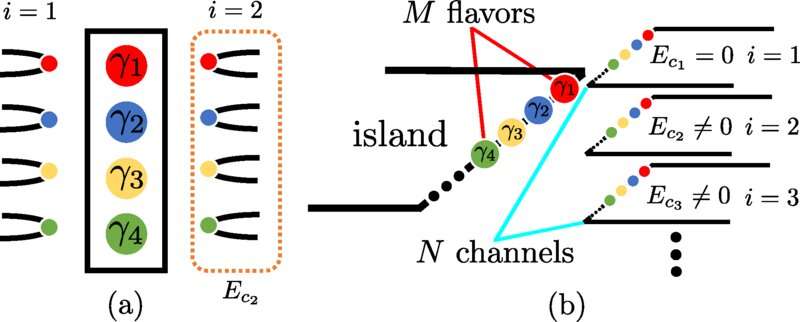This article has been reviewed according to Science X's editorial process and policies. Editors have highlighted the following attributes while ensuring the content's credibility:
fact-checked
peer-reviewed publication
trusted source
proofread
Proposed quantum device may succinctly realize emergent particles such as the Fibonacci anyon

Long before Dr. Jukka Vayrynen was an assistant professor at the Purdue Department of Physics and Astronomy, he was a post-doc investigating a theoretical model with emergent particles in a condensed matter setting. Once he arrived at Purdue, he intended to expand on the model, expecting it to be relatively easy.
He gave the seemingly straightforward calculations to Guangjie Li, a graduate student with whom he was working, but the calculations yielded an unexpected result. These results were a surprising roadblock that nearly brought their research to a screeching halt. Team tenacity has taken this roadblock and turned it into a possible route to the development of quantum computing.
At the Aspen Center for Physics in Colorado, Vayrynen discussed this issue with a colleague from the Weizmann Institute of Science in Israel, Dr. Yuval Oreg, who helped circumvent the obstacle. The team used this new understanding of their calculations to propose a quantum device that could be tested experimentally to succinctly realize emergent particles such as the Fibonacci anyon. They published their findings, "Multichannel topological Kondo effect," in Physical Review Letters on February 10, 2023.
Condensed matter theory is a field of physics that studies, for example, the properties of electronic quantum systems, with applications to technologies such as superconductors, transistors, or quantum computing devices. One of the challenges in this field is understanding the quantum mechanical behavior of many electrons, also known as the "many-body problem." It is a problem because it can only be theoretically modeled in very limited cases.
However, even in those limited cases, rich emergent phenomena such as collective excitations or fractionally charged emergent "quasi"-particles are known to emerge. These phenomena are a result of the complex interactions between electrons and can lead to the development of new materials and technologies.
"In our paper, we propose a quantum device that is simple enough to be theoretically modeled and tested experimentally in the future, yet also complex enough to display non-trivial emergent particles," says Vayrynen.
"Our results indicate that the proposed device can realize an emergent particle called a Fibonacci anyon that can be used as a building block of a quantum computer. The device is therefore a promising candidate for the development of quantum computing technology."
This discovery could be used in future quantum computers in a way that allows one to make them more resistant to decoherence, also known as noise.
According to their publication, the team introduced a physically motivated N-channel generalization of a topological Kondo model. Starting from the simplest case N = 2, they conjecture a stable intermediate coupling fixed point and evaluate the resulting low-temperature impurity entropy. The impurity entropy indicates that an emergent Fibonacci anyon can be realized in the N = 2 model.
According to Li, "a Fibonacci anyon is an emergent particle with the property that as you add more particles to the system, the number of quantum states grows like the Fibonacci sequence, 1, 2, 3, 5, 8, etc. In our system, a small quantum device is connected to conduction electron leads which will overly screen the device and can result in an emergent Fibonacci anyon."
The team also gives a number of predictions that could be experimentally tested in future quantum devices.
"We evaluate the zero-temperature impurity entropy and conductance to obtain experimentally observable signatures of our results. In the large-N limit we evaluate the full cross over function describing the temperature-dependent conductance," says Vayrynen.
This research is the first in a series that the Purdue team of Li and Vayrynen will work on. They collaborated with a senior scientist from Max Planck Institute for Solid State Research in Germany, Dr. Elio König, and posted a related work, "Topological Symplectic Kondo Effect" in a preprint arXiv on October 20, 2022.
More information: Guangjie Li et al, Multichannel Topological Kondo Effect, Physical Review Letters (2023). DOI: 10.1103/PhysRevLett.130.066302
Journal information: Physical Review Letters
Provided by Purdue University




















